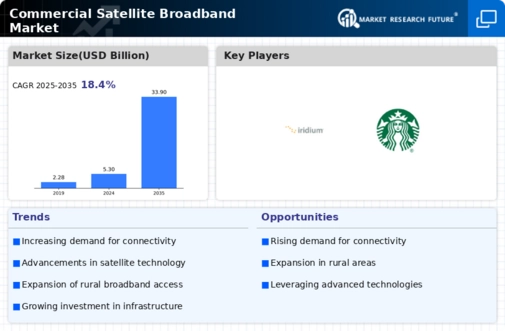Top Industry Leaders in the Commercial Satellite Broadband Market

Competitive Landscape of the Commercial Satellite Broadband Market:
The commercial satellite broadband market is experiencing a renaissance, driven by surging demand for connectivity in remote and underserved areas, growing adoption in maritime and aeronautical sectors, and advancements in satellite technology. Navigating this dynamic landscape requires an in-depth understanding of the key players, their strategies, and the factors shaping market share.
Key Players:
- Hughes Communications Ins.
- Visat Inc.
- Avon line Satellite Solutions Ltd
- Speedcast International Ltd
- Skycasters LLC
- Immarsat PLC
- Iridium Communications Inc
- star Inc.
Strategies for Success:
- Constellation Expansion: Players like Viasat are investing in next-generation LEO mega-constellations to expand coverage and capacity, aiming for global ubiquitous connectivity.
- Vertical Market Focus: Eutelsat, with its expertise in mobility and government communication, is targeting segments like aviation and maritime with specialized solutions.
- Technology Partnerships: Companies like Hughes Communications are collaborating with technology providers to integrate satellite broadband with fiber-optic networks, offering hybrid solutions for optimal performance.
- Service Diversification: Inmarsat is expanding beyond traditional voice and data services, offering IoT monitoring and edge computing solutions for remote infrastructure.
- Pricing Models: Players are adopting flexible pricing models like tiered plans and usage-based billing to cater to diverse customer needs and budgets.
Market Share Analysis:
- Geographic Concentration: While the market shows global growth, regional distribution of providers and demand remains uneven. North America and Europe account for a significant share, while emerging markets like Asia-Pacific and Latin America are witnessing rapid expansion.
- Technology Preference: LEO constellations are gaining traction due to their potential for lower latency and higher speeds, though traditional GEO satellites still hold ground due to wider coverage and established infrastructure.
- Regulatory Landscape: Government policies and spectrum allocation can significantly impact market dynamics. Countries like India and China are actively promoting domestic satellite constellations, potentially influencing global competition.
- End-User Demand: Market segments like maritime, mining, aviation, and rural communities, with limited terrestrial connectivity options, drive demand for satellite broadband solutions.
New and Emerging Companies:
- OneWeb, LeoSat Enterprises, and Telesat are building LEO constellations, challenging established players with potential for global, high-speed internet access.
- Swarm, Lynk Global, and Spire Global are focusing on narrowband IoT solutions leveraging LEO satellites, catering to remote asset tracking and data monitoring needs.
- Startups like Kymeta and Phasor are developing innovative antenna technologies that improve signal acquisition and performance, enhancing user experience.
Current Investment Trends:
- Constellation Build-out: Leading players are pouring billions into satellite launch and constellation expansion, driving significant technological advancements.
- Ground Infrastructure: Investments in ground stations and network connectivity hubs are crucial for seamless integration of satellite broadband with terrestrial networks.
- R&D: Research into advanced antenna technologies, improved bandwidth efficiency, and integration with emerging applications like 5G and IoT is a key focus area.
- Mergers and Acquisitions: Consolidation through M&As is expected to reshape the market landscape, with established players acquiring technology or market share from smaller competitors.
Latest Company Updates:
December 18, 2023, Despite the growth of satellite broadband, the digital divide still persists in many parts of the world. Affordability, accessibility, and digital literacy remain major challenges.
December 7, 2023, The deployment of new satellite constellations faces regulatory challenges, particularly regarding spectrum allocation and potential interference with existing satellites.
November 15, 2023, The increasing number of satellites in orbit raises concerns about space debris and potential collisions. Governments and space agencies are working on developing guidelines and regulations to mitigate these risks.

